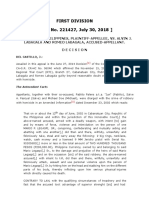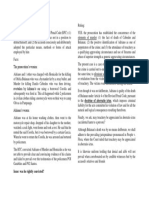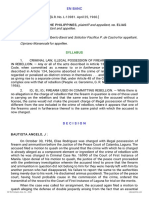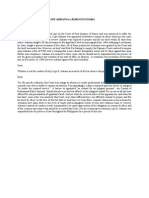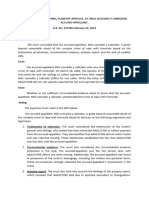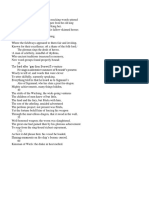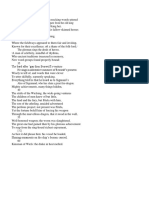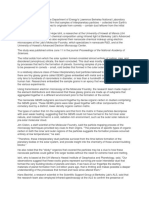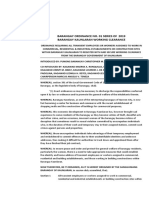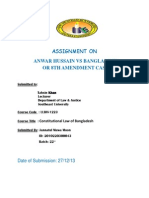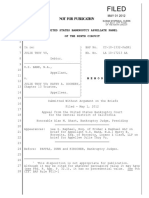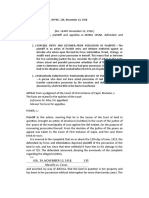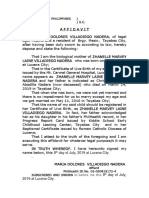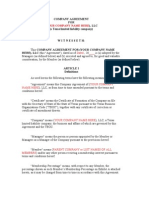PEOPLE OF THE PHILIPPINES V Comadre
PEOPLE OF THE PHILIPPINES V Comadre
Uploaded by
sashinaOriginal Description:
Original Title
Copyright
Available Formats
Share this document
Did you find this document useful?
Is this content inappropriate?
Copyright:
Available Formats
PEOPLE OF THE PHILIPPINES V Comadre
PEOPLE OF THE PHILIPPINES V Comadre
Uploaded by
sashinaCopyright:
Available Formats
PEOPLE OF THE PHILIPPINES, appellee, vs.
ANTONIO COMADRE
[G.R. No. 153559. June 8, 2004]
at around 7:00 in the evening of August 6, 1995, Robert Agbanlog with four others were having a drinking spree on
the terrace of the house of Robert's father when they noticed appellants Antonio Comadre, George Comadre and
Danilo Lozano stopped in front of the house. While his companions looked on, Antonio suddenly threw an object on
the roof of the terrace and fled immediately together with his companions. The object which happened to be a hand
grenade suddenly explode ripping a hole in the roof. Robert and his companions were hit by shrapnel and slumped
unconscious on the floor. They were all rushed to the Hospital however Robert died before reaching the hospital.
The undisputed facts show that when Antonio was in the act of throwing the hand grenade, his companions merely
looked on without uttering a single word of encouragement or performed any act to assist him. The trial court held
that the mere presence of the two provided encouragement and a sense of security to Antonio, thus proving the
existence of conspiracy.
Issue Can there be a conspiracy based on the foregoing facts?
Ruling
A conspiracy must be shown to exist as clearly and convincingly as the commission of the crime itself. Mere presence
of a person at the scene of the crime does not make him a conspirator for conspiracy transcends companionship.
The evidence shows that George Comadre and Danilo Lozano did not have any participation in the commission of
the crime and must therefore be set free. Their mere presence at the scene of the crime as well as their close
relationship with Antonio are insufficient to establish conspiracy considering that they performed no positive act in
furtherance of the crime.
Neither was it proven that their act of running away with Antonio was an act of giving moral assistance to his criminal
act. The ratiocination of the trial court that their presence provided encouragement and sense of security to Antonio,
is devoid of any factual basis. Such finding is not supported by the evidence on record and cannot therefore be a
valid basis of a finding of conspiracy.
People v. Comadre (G.R. No. 153559)
Facts: At around 7:00 o’clock in the evening of August 6, 1995, Robert Agbanlog, Jimmy Wabe, Gerry Bullanday, Rey
Camat and Lorenzo Eugenio were having a drinking spree on the terrace of the house of Robert’s father, Jaime
Agbanlog. Jaime was seated on the banister of the terrace listening to the conversation of the companions of his son.
As the drinking session went on, Robert and the others noticed appellants Antonio Comadre, George Comadre and
Danilo Lozano walking. The three stopped in front of the house. While his companions looked on, Antonio suddenly
lobbed an object which fell on the roof of the terrace. Appellants immediately fled by scaling the fence of a nearby
school.
The object, which turned out to be a hand grenade, exploded ripping a hole in the roof of the house. Robber
Agbanlog and his companions were hit by shrapnel and slumped unconscious on the floor. They were all rushed to
the hospital for medical treatment. However, Robert Agbanlog died before reaching the hospital for wounds sustained
which the grenade explosion inflicted. Robert’s companions sustained shrapnel injuries.
The appellants were arrested the following day but denied any participation in the incident, claimed they were
elsewhere when the incident occurred and that they had no animosity towards the victims whatsoever.
After trial, the court a quo convicted appellants of the complex crime of Murder with Multiple Attempted Murder for
having conspiring, confederating and mutually helping one another, with intent to kill and by means of treachery and
with the use of an explosive.
Issue: Whether or not the use of explosive qualifies the crime to murder?
Whether or not appellants conspired to kill the victims?
Held: Yes, the killing by means of explosives qualifies the crime to murder. The information alleges that both
treachery and the “use of explosive attended the crime.
Since both circumstances can qualify the killing to murder under Article 248 of the Revised Penal Code, the Supreme
Court held that when the killing is perpetrated with treachery and by means of explosives, the latter shall be
considered as a qualifying circumstance. Not only does jurisprudencesupport this view but also, since the use of
explosives is the principal mode of attack, reason dictates that this attendant circumstance should qualify the offense
instead of treachery which will then be relegated merely as a generic aggravating circumstance.
No, there was no conspiracy. The undisputed facts show that when Antonio Comadre was in the act of throwing the
hand grenade, George Comadre and Danilo Lozano merely looked on without uttering a single word of
encouragement or performed any act to assist him.
A conspiracy must be established by positive and conclusive evidence. It must be shown to exist as clearly and
convincingly as the commission of the crime itself. Mere presence of a person at the scene of the crime does not
make him a conspirator for conspiracy transcends companionship.
The evidence shows that George Comadre and Danilo Lozano did not have any participation in the commission of
the crime and must therefore be set free. Their mere presence at the scene of the crime as well as their close
relationship with Antonio are insufficient to establish conspiracy considering that they performed no positive act in
furtherance of the crime. There being no conspiracy, only Antonio Comadre must answer for the crime.
People vs. Manero (G.R. Nos.
You might also like
- Schaffer V WeastDocument6 pagesSchaffer V Weastapi-372339051Noch keine Bewertungen
- Baptiste LawsuitDocument42 pagesBaptiste LawsuitWTVCNoch keine Bewertungen
- Digest - People v. OritaDocument3 pagesDigest - People v. OritaDae Joseco100% (1)
- 61 Phil 703, PP Vs LamahangDocument3 pages61 Phil 703, PP Vs LamahanggcantiverosNoch keine Bewertungen
- People v. Nunag PDFDocument10 pagesPeople v. Nunag PDFJeanne G.Noch keine Bewertungen
- People V GerminaDocument2 pagesPeople V GerminaRubz JeanNoch keine Bewertungen
- People Vs TorpioDocument2 pagesPeople Vs TorpioColleen Fretzie Laguardia NavarroNoch keine Bewertungen
- People Vs Benjamin OngDocument81 pagesPeople Vs Benjamin OngNico de la PazNoch keine Bewertungen
- People v. Enfectana, 381 SCRA 359 (2002)Document8 pagesPeople v. Enfectana, 381 SCRA 359 (2002)Kristine May CisterNoch keine Bewertungen
- DEL CASTILLO V TORRECAMPODocument2 pagesDEL CASTILLO V TORRECAMPOMervin Jay SuaybaguioNoch keine Bewertungen
- Against Persons - Homicide & MurderDocument6 pagesAgainst Persons - Homicide & MurderSuiNoch keine Bewertungen
- People vs. Labagala (Full Text, Word Version)Document10 pagesPeople vs. Labagala (Full Text, Word Version)Emir Mendoza100% (1)
- LAW 109 - People v. Torpio (G.R. No. 138984)Document3 pagesLAW 109 - People v. Torpio (G.R. No. 138984)Aaron Cade CarinoNoch keine Bewertungen
- 105 People V DiscalsotaDocument4 pages105 People V DiscalsotaCharm CarreteroNoch keine Bewertungen
- People vs. GelaverDocument2 pagesPeople vs. GelaverSarah RomanoNoch keine Bewertungen
- US vs. Ferrer, GR No. 60Document4 pagesUS vs. Ferrer, GR No. 60Nikki Rose Laraga AgeroNoch keine Bewertungen
- People v. BañezDocument2 pagesPeople v. BañezKathleen del RosarioNoch keine Bewertungen
- Mamangun v. PeopleDocument7 pagesMamangun v. PeopleAndrei Anne PalomarNoch keine Bewertungen
- People v. Campuhan, G.R. No. 129433. March 30, 2000Document2 pagesPeople v. Campuhan, G.R. No. 129433. March 30, 2000Anna BarbadilloNoch keine Bewertungen
- People vs. Puedan, 388 SCRA 226, G.R. No. 139576, September 2, 2002Document9 pagesPeople vs. Puedan, 388 SCRA 226, G.R. No. 139576, September 2, 2002Olga Pleños ManingoNoch keine Bewertungen
- Criminal Law New 2Document4 pagesCriminal Law New 2Darwin BasaleNoch keine Bewertungen
- People Vs Adriano & SamsonDocument1 pagePeople Vs Adriano & SamsonSophiaFrancescaEspinosaNoch keine Bewertungen
- 11-15 Mitigating Cases For Crim LawDocument32 pages11-15 Mitigating Cases For Crim LawJohn Paul SuaberonNoch keine Bewertungen
- In Re Habeas Corpus of Pete Lagran Case DigestDocument1 pageIn Re Habeas Corpus of Pete Lagran Case DigestJerric CristobalNoch keine Bewertungen
- People v. Listerio, 335 SCRA 40 (2000) DigestDocument3 pagesPeople v. Listerio, 335 SCRA 40 (2000) DigestChristian SicatNoch keine Bewertungen
- 100 People v. Capalac, 1117 SCRA 874Document2 pages100 People v. Capalac, 1117 SCRA 874Princess MarieNoch keine Bewertungen
- People Vs BaelloDocument21 pagesPeople Vs BaelloNico de la PazNoch keine Bewertungen
- Case Digest On Intod v. CA (215 Scra 52 (1992) )Document1 pageCase Digest On Intod v. CA (215 Scra 52 (1992) )Dennis Earnshaw SalemNoch keine Bewertungen
- People Vs Lug-Aw DDocument2 pagesPeople Vs Lug-Aw DenarguendoNoch keine Bewertungen
- PEOPLE v. ROGADO Et Al.Document1 pagePEOPLE v. ROGADO Et Al.Cheonsa YoonNoch keine Bewertungen
- 95-96. Crim-Law-CaseDocument4 pages95-96. Crim-Law-CaseEthan KurbyNoch keine Bewertungen
- People vs. BagsitDocument1 pagePeople vs. BagsitSherwin C TapallaNoch keine Bewertungen
- People Vs AncajasDocument15 pagesPeople Vs AncajasYvon BaguioNoch keine Bewertungen
- Epifanio Vs PeopleDocument2 pagesEpifanio Vs PeopleWazzupNoch keine Bewertungen
- People Vs SumalpongDocument1 pagePeople Vs SumalpongRubz JeanNoch keine Bewertungen
- People vs. Lising, 285 SCRA 595 (G.R. No. 106210), (Jan. 30, 1998)Document1 pagePeople vs. Lising, 285 SCRA 595 (G.R. No. 106210), (Jan. 30, 1998)ryuseiNoch keine Bewertungen
- 2002Document6 pages2002John Paul Dumaguin CastroNoch keine Bewertungen
- People - v. - Elias Rodriguez PDFDocument4 pagesPeople - v. - Elias Rodriguez PDFJoy NavalesNoch keine Bewertungen
- In The Matter of Atty. Adriano vs. EstabiaDocument1 pageIn The Matter of Atty. Adriano vs. EstabiaCresal Grace MalabananNoch keine Bewertungen
- De Guzman V. People G.R. No. 178512, November 26, 2014 Bersamin, J. FactsDocument2 pagesDe Guzman V. People G.R. No. 178512, November 26, 2014 Bersamin, J. Facts'Elainne EncilaNoch keine Bewertungen
- CRIM Batch 5Document10 pagesCRIM Batch 5Rachelle CasimiroNoch keine Bewertungen
- People v. FernandezDocument1 pagePeople v. FernandezAlec VenturaNoch keine Bewertungen
- Art. 14 - People vs. Laguardia GR L-63423 February 27, 1987Document4 pagesArt. 14 - People vs. Laguardia GR L-63423 February 27, 1987Lu CasNoch keine Bewertungen
- People Vs Laguardia Et. AlDocument6 pagesPeople Vs Laguardia Et. AlZusmitha SalcedoNoch keine Bewertungen
- SELF-DEFENSE and FULFILLMENT OF DUTY - BAXINELA vs. PEOPLEDocument1 pageSELF-DEFENSE and FULFILLMENT OF DUTY - BAXINELA vs. PEOPLEPrincessClarizeNoch keine Bewertungen
- Statutory Construction Cases (Digest)Document7 pagesStatutory Construction Cases (Digest)andrea ibanezNoch keine Bewertungen
- Re Report On The Judicial Audit Conducted in The Regional Trial Court Branch 24, Cebu CityDocument5 pagesRe Report On The Judicial Audit Conducted in The Regional Trial Court Branch 24, Cebu CityEmir MendozaNoch keine Bewertungen
- People of The Philippines v. Leocadio LabaradorDocument2 pagesPeople of The Philippines v. Leocadio LabaradorLeorebelle RacelisNoch keine Bewertungen
- G.R. No. 117954 - People Vs Acuram (27 Apr 00)Document6 pagesG.R. No. 117954 - People Vs Acuram (27 Apr 00)jdz1988Noch keine Bewertungen
- 5.the United States vs. Villanueva-Rama, J.Document2 pages5.the United States vs. Villanueva-Rama, J.Elyka SataNoch keine Bewertungen
- Characteristics of Criminal Law: Criminal Liability (Who May Incur?) Classes of FelonyDocument6 pagesCharacteristics of Criminal Law: Criminal Liability (Who May Incur?) Classes of FelonyJohn PatrickNoch keine Bewertungen
- 003 - Liang v. PeopleDocument2 pages003 - Liang v. PeopleBryce KingNoch keine Bewertungen
- Rodolfo Guevarra v. People, G.R. No. 170462, February 5, 2014Document1 pageRodolfo Guevarra v. People, G.R. No. 170462, February 5, 2014Greta Fe DumallayNoch keine Bewertungen
- US Vs Calixto ValdezDocument1 pageUS Vs Calixto ValdezJoyleen HebronNoch keine Bewertungen
- Yao Vs Perello Case DigestDocument2 pagesYao Vs Perello Case DigestGem S. AlegadoNoch keine Bewertungen
- Previously For An Offense To Which The Law Attaches An EqualDocument1 pagePreviously For An Offense To Which The Law Attaches An EqualRod Ralph ZantuaNoch keine Bewertungen
- 52 Manaban - v. - Court - of - AppealsDocument9 pages52 Manaban - v. - Court - of - AppealsKristelle TabaoNoch keine Bewertungen
- People Vs UralDocument2 pagesPeople Vs UralabbyNoch keine Bewertungen
- Veneracion v. Mancilla (2006)Document2 pagesVeneracion v. Mancilla (2006)Andre Philippe RamosNoch keine Bewertungen
- People V. Ortega G.R. No. 116736, July 24, 1997 Panganiban, J. Thesis StatementDocument3 pagesPeople V. Ortega G.R. No. 116736, July 24, 1997 Panganiban, J. Thesis StatementHaengwoonNoch keine Bewertungen
- Mistake of Fact Case DigestsDocument8 pagesMistake of Fact Case Digestsdrae velascoNoch keine Bewertungen
- People Vs ComadreDocument1 pagePeople Vs ComadreMeAnn Tumbaga50% (2)
- Terrorem Effect Resulting From Their Very Existence, And, If Facial Challenge IsDocument2 pagesTerrorem Effect Resulting From Their Very Existence, And, If Facial Challenge IssashinaNoch keine Bewertungen
- Motion To Quash, and Five (5) Days Later or On 26 June 2001 Petitioner Submitted Motion To QuashDocument1 pageMotion To Quash, and Five (5) Days Later or On 26 June 2001 Petitioner Submitted Motion To QuashsashinaNoch keine Bewertungen
- His Body Did BurstDocument1 pageHis Body Did BurstsashinaNoch keine Bewertungen
- Combination or Series of Overt or Criminal ActsDocument2 pagesCombination or Series of Overt or Criminal ActssashinaNoch keine Bewertungen
- Doubt Is To Sustain."Document1 pageDoubt Is To Sustain."sashinaNoch keine Bewertungen
- How Animals Holler: Moving Air EfficientlyDocument2 pagesHow Animals Holler: Moving Air EfficientlysashinaNoch keine Bewertungen
- Hurricanes: Stronger, Slower, Wetter in The Future?Document2 pagesHurricanes: Stronger, Slower, Wetter in The Future?sashinaNoch keine Bewertungen
- I Had Given Up All Hope, When This Brave Liegeman Came To Our AidDocument1 pageI Had Given Up All Hope, When This Brave Liegeman Came To Our AidsashinaNoch keine Bewertungen
- Gainst The FriendDocument1 pageGainst The FriendsashinaNoch keine Bewertungen
- Giant Invasive Flatworms Found in France and Overseas French TerritoriesDocument1 pageGiant Invasive Flatworms Found in France and Overseas French TerritoriessashinaNoch keine Bewertungen
- Dino-Bird Dandruff Research Head and Shoulders Above RestDocument1 pageDino-Bird Dandruff Research Head and Shoulders Above RestsashinaNoch keine Bewertungen
- Gainst The FriendDocument1 pageGainst The FriendsashinaNoch keine Bewertungen
- Experiments Trace Interstellar DustDocument2 pagesExperiments Trace Interstellar DustsashinaNoch keine Bewertungen
- Proceedings of The National Academy of SciencesDocument2 pagesProceedings of The National Academy of SciencessashinaNoch keine Bewertungen
- A Lustre Unlovely Likest To FireDocument1 pageA Lustre Unlovely Likest To FiresashinaNoch keine Bewertungen
- Artificial IntelligenceDocument2 pagesArtificial IntelligencesashinaNoch keine Bewertungen
- Diamond DustDocument2 pagesDiamond DustsashinaNoch keine Bewertungen
- Pestilos V. People: Criminal Procedure Case DigestDocument2 pagesPestilos V. People: Criminal Procedure Case DigestJamiah Obillo HulipasNoch keine Bewertungen
- 17 Soriano v. BSPDocument6 pages17 Soriano v. BSPChester BryanNoch keine Bewertungen
- Ordinance For Working ClearanceDocument3 pagesOrdinance For Working ClearanceJoan Perez100% (1)
- Pharma0613ra ManilaDocument73 pagesPharma0613ra ManilaScoopBoyNoch keine Bewertungen
- Assignment On Anwar Hussain Vs Bangladesh or 8Th Amendment CaseDocument3 pagesAssignment On Anwar Hussain Vs Bangladesh or 8Th Amendment Caseashif28Noch keine Bewertungen
- Filed: Not For PublicationDocument20 pagesFiled: Not For PublicationScribd Government DocsNoch keine Bewertungen
- (B232) LAW 100 - Modequillo v. Breva (GR No. 86355)Document2 pages(B232) LAW 100 - Modequillo v. Breva (GR No. 86355)Agent BlueNoch keine Bewertungen
- Kami Export - Mon - SSCG3.c-Constitution ReadingDocument3 pagesKami Export - Mon - SSCG3.c-Constitution ReadingMonica RobinsonNoch keine Bewertungen
- U.S. v. Enrique Pere YcazaDocument18 pagesU.S. v. Enrique Pere YcazaMike KoehlerNoch keine Bewertungen
- Pgd-Test DrillDocument11 pagesPgd-Test Drillkristel ludangcoNoch keine Bewertungen
- Mischief Rule of Interpretation: Intention. Originating From A 16th Century Case inDocument8 pagesMischief Rule of Interpretation: Intention. Originating From A 16th Century Case inPawanpreet SinghNoch keine Bewertungen
- NOTICE of APPEALDocument2 pagesNOTICE of APPEALBernice Joana L. PiñolNoch keine Bewertungen
- 5A. Masallo vs. Cesar., 39 Phil., 134, November 13, 1918Document4 pages5A. Masallo vs. Cesar., 39 Phil., 134, November 13, 1918Christian MartinezNoch keine Bewertungen
- Alcantara v. Alcantara, GR 167746Document5 pagesAlcantara v. Alcantara, GR 167746Peter RojasNoch keine Bewertungen
- Eric Godfrey Stanley Livesey vs. Binswanger Phils., Inc., Et. Al.Document9 pagesEric Godfrey Stanley Livesey vs. Binswanger Phils., Inc., Et. Al.BERNADETTE SONoch keine Bewertungen
- Affidavit of Acknowledgment of Unwed MotherDocument3 pagesAffidavit of Acknowledgment of Unwed MotherAmelyn MoteNoch keine Bewertungen
- CRIM 2 Case DigestsDocument11 pagesCRIM 2 Case DigestsJose Dagala100% (1)
- 114277-2002-Vda. de Daffon v. Court of AppealsDocument7 pages114277-2002-Vda. de Daffon v. Court of AppealsKarl OdroniaNoch keine Bewertungen
- Constitutional Law Project Sem 4Document16 pagesConstitutional Law Project Sem 4Vijay Srinivas KukkalaNoch keine Bewertungen
- Knowledge Is Power: Atty. Behn Joseph O Tesiorna LecturerDocument38 pagesKnowledge Is Power: Atty. Behn Joseph O Tesiorna LecturerSparks ManNoch keine Bewertungen
- Miranda Vs AlvarezDocument26 pagesMiranda Vs AlvarezajdgafjsdgaNoch keine Bewertungen
- HumssDocument13 pagesHumssJohn Benedict CustodiaNoch keine Bewertungen
- Eu Exam 2020 (Oct) BDocument3 pagesEu Exam 2020 (Oct) BKanzah Sohail HaiderNoch keine Bewertungen
- Discovery of DocumentsDocument3 pagesDiscovery of DocumentsNur Syafiqah YusoffNoch keine Bewertungen
- Bernardo v. BataclanDocument1 pageBernardo v. BataclanNamiel Maverick D. BalinaNoch keine Bewertungen
- Company Agreement For Texas LLCDocument6 pagesCompany Agreement For Texas LLCLuks Cabaret100% (1)
- People v. NideraDocument7 pagesPeople v. NideraKim Jan Navata BatecanNoch keine Bewertungen
- Application Under Section 436 of CR PC For The Grant of BailDocument3 pagesApplication Under Section 436 of CR PC For The Grant of BailnankiarnejaNoch keine Bewertungen











